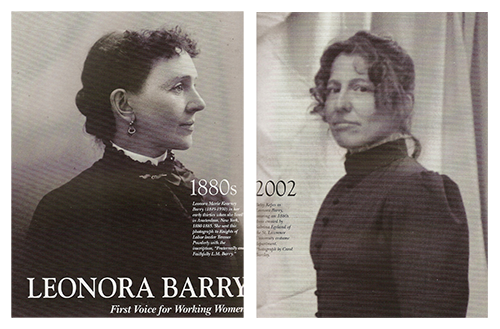

Take a careful look at this photo from 1886. The tightly corseted women are the female face of organized labor in America. These women were delegates to the General Assembly of the Knights of Labor, a union with the radical platform of “equal pay for equal work.” The baby is Lizzie Rogers, the tenth child of Mrs. Rodgers, a housewife who was also in charge of much of the union’s work in Chicago.
The woman who interests me the most is the tall woman in the center of the back row, the one with the hat and brooch. Leonora Marie Kearney Barry arrived in the United States as a three-year-old in 1852 as her family fled the devastation left in Ireland after the Potato Famine. She grew up in Pierrepont, NY, near where I now live. After a series of tragedies, including the death of her husband and her eight-year-old daughter, she began work in a knitting mill in Amsterdam, NY. The conditions there appalled her and when she learned of the chance to join the Knights of Labor she did. She soon led the Victory Assembly, a group of 1,500 working women including mill workers, milliners and music teachers. Here’s what “Sister Barry” later said about her Amsterdam colleagues: “And let me say to you here that although there was not one amongst them who could boast of more than a minor part of a common school education, yet in that body of women there was more executive ability, more tact, more shrewdness, more keen calculating power than could be found in twice that number of men in the United States.”
During the 1886 convention, the women in the photo elected Leonora Barry as the General Investigator of Women’s Work. Barry traveled constantly, giving motivational speeches and listening to working women and children. She wrote detailed reports of what she witnessed and was much sought after as a speaker. After the Knights of Labor fell apart, she continued on as a public persona, working to promote Temperance and later as a speaker for the mid-west Chautuaqua circuit.
Leonora Barry and Betsy Kepes
My fascination with Leonora Barry led me to apply for a grant to have a costume designed and made for me. In that dress (and horribly uncomfortable corset) I can be Leonora Barry for school groups, Girl Scouts and service and historical organizations.
—
Radio Programs
Leonora Barry, First Voice for Working Women (NCPR)
This 30 minute radio documentary won awards from the Syracuse Press Club and NYS Associated Press. It has many actors’ voices and wonderful celtic music.
Susan B. Anthony in the North Country (NCPR)
This was another fun project. Now that old newspapers have been scanned and are online it’s possible to do searches for names. I was able to trace Miss Anthony’s journeys in the top part of NYS and her transformation from laughing stock to revered leader.
No Bigger than a Piano Box (NCPR)
One hundred years ago teenage girls and boys would teach in rural one-room schools, often before they attended high school. When I found a diary written by a sixteen-year-old teacher I built this 30 minute program around it.
Women on High by Rebecca Brown (NCPR)
This is the first book review I wrote for North Country Public Radio. My boss, Martha Foley, asked if I’d like to review the book and I was thrilled to do so. I’ve never been a technical mountain climber but I’ve climbed many peaks. It was fascinating to learn about the first women climbers.
